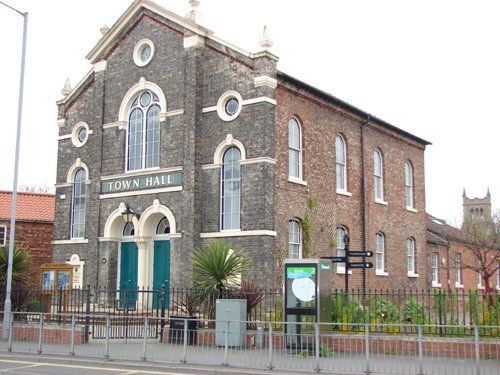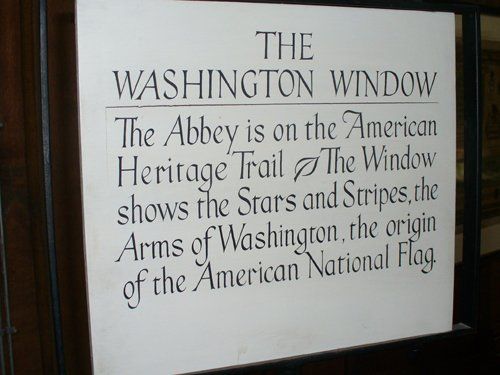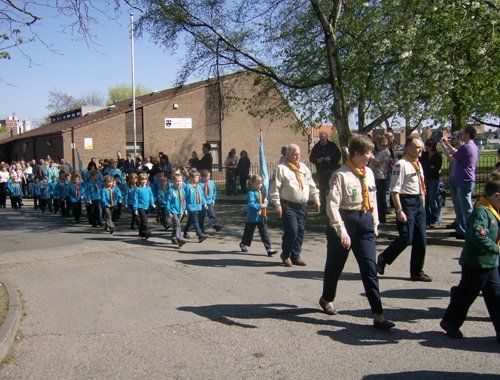back

Selby is a town and civil parish in North Yorkshire, England, situated 22,5 km south of the city of York and
30 km east of the city of Leeds, along the course of the River Ouse. Selby is the largest and, with a population of about 14.500 in 2017 most populous settlement of the wider Selby local government district.
According to a legend Selby was founded from Danish Vikings in the 10th century. The Danish founders arrived at today´s city on the waterway of the river Ouse.
In another legend the river Ouse plays a significant role: The Abbey was founded when Benedict saw three swans on a lake in Selby (1069), and he saw it as a sign of the Father, Son and Holy Ghost. That is why the official crest of Selby Abbey is three swans. Selby Abbey was closed in 1539 as part of the Dissolution of the Monasteries under Henry VIII and the majority of the buildings have since been demolished. The central nave of the Abbey church survived and in 1618 it became the parish church of Selby.
A notable feature of the abbey is the 14th century Washington Window, featuring the heraldic arms of the ancestors of George Washington, the first president of the United States. The design is often cited as an influence for the Stars and Stripes flag.
Further events of Selby: There was also a very important battle in the English Civil War, named the Battle of Selby (1644); a connecting to the English railway system (1840); an opening of the railway line Selby to Leeds (1841).
For a time, Selby was the leading coal mining area in the UK and featured some of the most advanced mining technology in Europe. It was the first new mine in the UK for decades and was seen as a rejoinder to widespread concern that the British mining industry was effectively shutting down, particularly following the defeat of the 1984-85 miners' strike which was part of the Selby Coalfield holds the UK record for coal mined in one week—200,743 tonnes in 1995. The 110 square mile (285 km²) Selby Complex, employing 3,000 miners plus contractors and ancillary staff, closed on Friday
14th May 2004 despite rising demand for coal in the UK. UK Coal, the pit's owner, said closure was due to rising costs caused by deteriorating geological conditions and the falling price of coal. In its final years, the company listed a £ 30 million loss on the plant.
Much of the historical wealth of the town is based upon its position upon the banks of the tidal River Ouse. In the past, Selby had a large shipbuilding industry and was an important port, due to the Selby Canal which brought trade from Leeds. The Selby Canal links the River Ouse at Selby, to the River Aire at Haddlesey. The current Greenpeace craft bearing the name Rainbow Warrior was built in Selby in 1957.
Present day, the main income for the area is derived from arable farming and as a commuter area for Leeds, Wakefield and York. Its popularity as a tourist destination, due to Selby Abbey, has led to a large amount of development and renovation in the town and surrounding area.
In recent years there have been serious flood problems in Selby and the adjoining village of Barlby. The threat in the Barlby area has been alleviated to some extent by work on improved, better flood barriers following the major flood of November 2000.
At the lowest level of governance Selby has a town council. The town is divided into three electoral wards, north, south and west, each represented by six councillors. These eighteen councillors are responsible for burial grounds, allotments, play areas and some street lighting. Elections to the town council are held every four years. At district level the town is part of the Selby District Council area. The town is represented by seven councillors on the District Council, two each for the west and south wards and three for the north ward. On the North Yorkshire County Council the town is part of the Selby Barlby county division which elects two representatives to the County Council. In the United Kingdom Parliament Selby formed part of the Selby constituency until the 2010 general election when it became part of the new seat of Selby and Ainsty. The town is represented at the European level as part of the Yorkshire and the Humber constituency.

Selby
Selby is a town and civil parish in North Yorkshire, England, situated 22,5 km south of the city of York and
30 km east of the city of Leeds, along the course of the River Ouse. Selby is the largest and, with a population of about 14.500 in 2017 most populous settlement of the wider Selby local government district.
According to a legend Selby was founded from Danish Vikings in the 10th century. The Danish founders arrived at today´s city on the waterway of the river Ouse.
In another legend the river Ouse plays a significant role: The Abbey was founded when Benedict saw three swans on a lake in Selby (1069), and he saw it as a sign of the Father, Son and Holy Ghost. That is why the official crest of Selby Abbey is three swans. Selby Abbey was closed in 1539 as part of the Dissolution of the Monasteries under Henry VIII and the majority of the buildings have since been demolished. The central nave of the Abbey church survived and in 1618 it became the parish church of Selby.
A notable feature of the abbey is the 14th century Washington Window, featuring the heraldic arms of the ancestors of George Washington, the first president of the United States. The design is often cited as an influence for the Stars and Stripes flag.
Further events of Selby: There was also a very important battle in the English Civil War, named the Battle of Selby (1644); a connecting to the English railway system (1840); an opening of the railway line Selby to Leeds (1841).
For a time, Selby was the leading coal mining area in the UK and featured some of the most advanced mining technology in Europe. It was the first new mine in the UK for decades and was seen as a rejoinder to widespread concern that the British mining industry was effectively shutting down, particularly following the defeat of the 1984-85 miners' strike which was part of the Selby Coalfield holds the UK record for coal mined in one week—200,743 tonnes in 1995. The 110 square mile (285 km²) Selby Complex, employing 3,000 miners plus contractors and ancillary staff, closed on Friday
14th May 2004 despite rising demand for coal in the UK. UK Coal, the pit's owner, said closure was due to rising costs caused by deteriorating geological conditions and the falling price of coal. In its final years, the company listed a £ 30 million loss on the plant.
Much of the historical wealth of the town is based upon its position upon the banks of the tidal River Ouse. In the past, Selby had a large shipbuilding industry and was an important port, due to the Selby Canal which brought trade from Leeds. The Selby Canal links the River Ouse at Selby, to the River Aire at Haddlesey. The current Greenpeace craft bearing the name Rainbow Warrior was built in Selby in 1957.
Present day, the main income for the area is derived from arable farming and as a commuter area for Leeds, Wakefield and York. Its popularity as a tourist destination, due to Selby Abbey, has led to a large amount of development and renovation in the town and surrounding area.
In recent years there have been serious flood problems in Selby and the adjoining village of Barlby. The threat in the Barlby area has been alleviated to some extent by work on improved, better flood barriers following the major flood of November 2000.
At the lowest level of governance Selby has a town council. The town is divided into three electoral wards, north, south and west, each represented by six councillors. These eighteen councillors are responsible for burial grounds, allotments, play areas and some street lighting. Elections to the town council are held every four years. At district level the town is part of the Selby District Council area. The town is represented by seven councillors on the District Council, two each for the west and south wards and three for the north ward. On the North Yorkshire County Council the town is part of the Selby Barlby county division which elects two representatives to the County Council. In the United Kingdom Parliament Selby formed part of the Selby constituency until the 2010 general election when it became part of the new seat of Selby and Ainsty. The town is represented at the European level as part of the Yorkshire and the Humber constituency.













